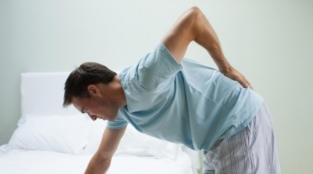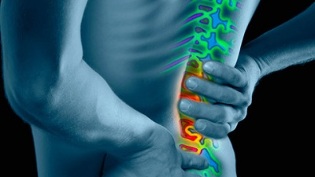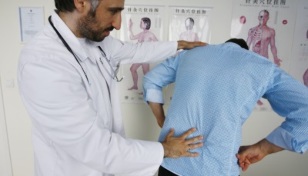Despite opinions, spinal necrosis is not considered part of the aging process. The elastic discs between the vertebrae are responsible for bending and stretching the back, like a shock absorber. Over time, they wear out and no longer provide full motion. With age, daily stress on the spine and accidental injuries, including minor ones, can damage the back disc and lead to lumbar spinal necrosis.
Who has this lower back disease?

In most cases, the first symptoms of lumbar spinal necrosis occur at the age of 11-12 years old. The disease manifests itself vividly at the age of 16, but the most severe and frequent complications occur between the ages of 15 and 20.
Children under 15 years of age rarely develop severe forms of bone necrosis, which is related to the excellent condition of the musculoskeletal system in general and the spine in particular. In addition, the disease takes time to develop, taking on average 5 years.
Fortunately, these diseases are much easier to treat in children than in adults.
Symptoms
The reflex syndrome
- Neck pain- various symptoms in the neck (pulling, tingling, shooting), a feeling of "crawling" in the neck muscles, as well as decreased mobilityand flexibility of the neck.
- Low back painis a sharp, sharp pain in the lower back, which may be accompanied by numbness or swelling. Instead of the word "low back pain", you can use the words "low back pain" or "migraine".
- Chest pain- pain of a different nature in the chest, shoulder blades and ribs, frequently occurring or occurring during body movements.
Compression syndrome
Occurrence of pain syndrome in lumbar spinal necrosis is due to:
- Compression of the root structure (patient root).
- Spinal cord compression (myelopathy).
- Damage to the spinal cord due to an impaired blood supply.
- Stenosis (stenosis) of arteries and veins (myocardial ischemia due to compression of blood vessels).
Methods of detecting diseases
Differential Diagnosis
Not every disorder can be diagnosed with a simple laboratory test. Many conditions cause similar symptoms. For example, many infections cause fever, headache and fatigue.
Many mental disorders are caused by:

- sadness;
- care;
- sleep problems.
The differential diagnosis identifies the disorders that may cause symptoms. Usually, this diagnosis is based on a number of tests. These tests may rule out conditions and / or determine if you need additional testing.
Differential diagnosis is used to diagnose physical or mental health problems that cause similar symptoms.
Differential diagnosis is also commonly used in the field of psychiatry / psychology, where two different diagnoses can be made for a patient with symptoms of certain diseases. For example, a patient diagnosed with bipolar disorder may also be differentially diagnosed with boundary personality disorder, with similarity in symptoms of both conditions.
Who is diagnosed more often?
If previously the disease was diagnosed in sick people after the age of 45, today about 27% of adolescents suffer from bone necrosis of one degree or another.
Such a massive spread of the disease is understandable - children begin to spend a lot of time in sitting posture, including using computers and the Internet. It's not bad? Time will tell, but reality remains - the cost of sedentary lifestyles is high, and osteonecrosis is not the worst disease that can happen with such a lifestyle, but it is radical. the most common disease (after obesity).
How do I define a disease and its extent?
First
In the normal state, the discs continuously regenerate, but the process is slowed down and a disease such as 1st degree bone necrosis occurs.
There are several reasons for this:

- obesity; metabolic disorders
- ; immunocompromised
- , v. v.
Unfortunately, the instability of pain in a given degree of disease is affected by the fact that many people ignore diagnosis and treatment, and try to cure the pain on their own. To do this, use different ointments and alcohol. But this is the biggest mistake.
Degree 1 lumbar spinal fibroids can be cured quite easily by contacting a good specialist and performing some simple operations.
Degree 1 fibroids are compression of disc cartilage in the lumbar region. The main symptom at this stage is slight pain when swiveling or bending. Sometimes symptoms are more acute and short-lived due to sudden movement or exertion.
Second
An obvious symptom of the disease is soreness in the lower back, which increases with movement. The pain can spread higher to the spine.
With bone necrosis, the pain can spread to the lower extremities.
The second stage of bone necrosis is characterized by intense pain that manifests itself even with a cough.
Other symptoms associated with pinched nerve ends:
- The sensitivity of the lower extremities changed. The main signs are: pain, numbness in the legs, high or low sensitivity of the lower extremities.
- Limited mobility. A person with bone necrosis (grade 2) finds that as the disease progresses, it is very difficult to move.
- Increases fatigue and continuous sleepiness. The patient is chronically tired, accompanied by irritability. This symptom is explained by the pain syndrome that is constantly bothering the patient.
- Difficult and painful urination in the kidney area.
Tuesday

By the time of stage 3, the patient's posture has changed markedly. In more advanced cases, bone deformation occurs. At this stage of lumbar spondylolisthesis, the patient's general physical and / or mental condition is also markedly impaired and a deep loss of energy.
The third stage is characterized by the appearance of the shrinking of the padding against the background of the previous changes. Disc herniations are formed, blood vessels in the neck and muscles are damaged. Patients with dizziness, pain in the back of the head.
Wed
The final stage occurs when the disk becomes degraded and the disk space is destroyed. At this stage, disc thinning reaches its maximum or even worse completely disappears. Postural imbalances are severe, and movement and flexibility are extremely limited.
Stage 4 lumbar spondylitis is usually characterized by severe pain and a higher degree of decline in physical and / or mental condition. It can also permanently lose growth and energy. Stage 4 is generally considered irreversible.
Doctor consultation
Which doctor should I contact?
When independent treatments ceased to provide pain relief, patients began to ask: who is the doctor who treats osteonecrosis? The first person you can turn to for lumbar fibroids is your local therapist. But in this situation, he plays the role of a coordinator, as he will not be able to fully prescribe the treatment - this is not his specialty.
Chances are, he will take you to a psychiatrist. It is this specialist who will conduct the necessary research and help build a treatment program. The therapist may also refer you to a chiropractor. This doctor deals directly with diseases of the spine.
Weigh and check
Quality of life rating

General characteristics such as quality of life are especially important for a group of patients with comorbid conditions, as they can affect the effectiveness of treatment. This is especially important to compare the results of several studies, to economic analysis and to understand the whole problem.
Methods of quality of life include:
- Oswestry Quality of Life Questionnaire.
- Roland-Morris questionnaire.
- Stratford scale.
- Quebec Back Pain Scale - questionnaire about how back pain affects your daily life).
Pain Score
Pain is an unpleasant sensation and emotional experience related to tissue damage. Its purpose is to help the body respond and prevent further tissue damage.
Methods to evaluate pain syndrome include:
- Achieves the Korf Chronic Pain Assessment Scale.
- McGill's pain questionnaire.
- Verbal pain score.
Evaluation of treatment results
- McNab's subjective rating scale.
- Measurement of patient satisfaction.
- Prolo's functional and economic performance scale.
- Lumbosacral result scale.
- The Nurik Scale.
Hardware Check
X-ray
X-rays provide detailed skeletal structure in the spine and are used to eliminate back pain caused by:
- Spondylolisthesis.
- Tumor.
- Cracks.
The calcium in the bone prevents X-ray penetration, and the image of the bone is treated as a shadow on film. X-rays provide excellent visibility of all details as the bones are made up largely of calcium. However, since the disc and nerve roots do not contain calcium, X-rays do not capture these structures. Therefore, X-rays cannot be used to diagnose lumbar disc herniation or other causes of a pinched nerve.
X-rays are not recommended for pregnant women.
Potential complications and consequences
Complications and possible consequences of necrosis of the lumbar spine include:
- Myopathy is a condition characterized by a nerve root disease.
- Muscle weakness - Common symptoms include fever, fatigue, flu-like symptoms, paresthesia, weight loss and change in consciousness.
- Bladder nerve - problems with the nerves that control the bladder and urinate
- Damage to the lower motor neurons.
- Raynaud's is a constriction of the capillaries of the fingers and toes.
- Pain in the neck, back, and legs.
Treatment
Treatment may vary depending on the severity of your symptoms and how well they restrict your daily activities.
Here are some treatments your doctor may prescribe based on your pain level:
- Non-surgical treatment- not all patients with osteonecrosis require surgical intervention. For mild to moderate pain, the treatments are more conservative.
- Spondylodesis- surgical intervention in the treatment of osteonecrosis.
Precautions

Prevention of lumbar necrosis is to eliminate risk factors for this disease. Elimination of factors is the primary precautionary measure.
The physical activity is normalized, the back muscles are strengthened, reducing the maximum load to the lower back, preventing the development of diseases that lead to lower back pain, all of this is preventivesymptoms of lumbar degenerative disease.
Moderate exercise, lifestyle changes, and good nutrition can help prevent painful and disabling symptoms.
If you notice symptoms of lumbar spondylolisthesis in yourself, do not tighten and consult a doctor immediately. Timely caught disease is easier to treat and proceed with no consequences.

























